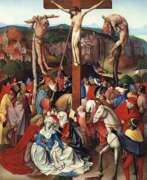Holy Roman Empire 15th century


Albrecht Dürer, born on May 21, 1471 in Nuremberg, Germany, is widely regarded as the greatest German Renaissance painter. His contribution to painting and engraving is quite significant and has left a notable mark on the art world. Dürer's early life was spent in Nuremberg, a city that played a crucial role in his development as an artist and was also the site of his death on April 6, 1528. He was the son of the goldsmith Albrecht Dürer the Elder, from whom he initially learned the basics of drawing and metalworking.
Dürer's work is characterized by a combination of Gothic elements with the emerging Renaissance style, which is evident in his woodcuts and engravings. His oeuvre encompasses many themes, including religious works, altarpieces, portraits, and self-portraits. His outstanding prints, such as The Knight, Death and the Devil (1513), St. Jerome in his Study (1514) and Melencolia I (1514), are known for their intricate detail and artistic skill. Dürer was also one of the earliest European landscape painters, as evidenced by his watercolor paintings.
Equally significant are his theoretical writings on mathematics, perspective, and ideal proportions in art. Dürer was not only an artist but also a keen intellectual, his interests encompassing various aspects of culture and science. He served as court painter to Holy Roman Emperors Maximilian I and Charles V, completing several significant art projects for them. Dürer's keen mind and versatile interests brought him into contact with the most prominent figures of his time, including theologians and scientists of the Reformation era.
Dürer's self-portraits are particularly famous, demonstrating not only his artistic skill but also his self-awareness and personal style. These portraits attest to his growing success and confidence as an artist. Dürer's legacy is immense; he influenced not only the art of his time, but also left an indelible mark on the history of European art.
For those interested in the work and legacy of Albrecht Dürer, we recommend subscribing to our updates. Our subscription service is designed to provide information about new sales and auction events related to this remarkable artist. Join us to keep up to date on the latest art and antiques related to Albrecht Dürer.


Matthias Grünewald was a German Renaissance painter, celebrated for his deeply emotional and vivid religious works that diverged significantly from the classical influences of the Renaissance to embrace a more intense, expressive style. Born around 1480 in Würzburg, Germany, and passing in August 1528, Grünewald's artistry remains a beacon of visionary expressiveness, marked by its intense coloration and agitated lines, making him one of the most remarkable German painters of his time.
Grünewald's most renowned work, the Isenheim Altarpiece, created for the monastery at Isenheim, Alsace, between 1512 and 1516, showcases his unparalleled ability to depict religious fervor and human suffering with a raw intensity. This masterpiece, now housed in the Unterlinden Museum in Colmar, France, is celebrated for its intricate detail, emotional depth, and innovative use of color and light. The altarpiece, with its depictions of the Crucifixion, the Temptation of St. Anthony, and the Resurrection, among others, is a pivotal work that resonates with themes of pain, redemption, and hope, reflecting Grünewald's profound religious and mystical inclinations.
Aside from the Isenheim Altarpiece, Grünewald's oeuvre includes several other notable works. His paintings are primarily found in Germany, with notable exceptions such as a small Crucifixion in Washington and another in Basel, Switzerland. His contributions to the Heller Altarpiece in Frankfurt, alongside works by Albrecht Dürer, although partly destroyed, further attest to his skill and innovative approach to religious painting.
Grünewald's legacy extends beyond his paintings. By the late 19th century, he was rediscovered and became a figure of admiration among German Nationalists and Modernists, drawn to the expressive emotionality of his work. His influence is evident in various cultural expressions, including literature and music, where his life and works have inspired novels and operas, underscoring his lasting impact on not only art but also on German cultural identity.
For collectors and experts in art and antiques, the emotional intensity and historical significance of Matthias Grünewald's work make his paintings highly sought after. His unique approach to religious themes, combining deep spirituality with a dramatic visual style, continues to captivate and inspire. If you're keen on exploring the profound depths of Grünewald's artistry and wish to stay informed about new discoveries, sales, and auction events related to his work, signing up for updates is a step into the world of one of the Renaissance's most enigmatic figures. This subscription ensures you're always at the forefront of the latest insights and opportunities related to Matthias Grünewald's enduring legacy.


Bartholomäus Zeitblom was a German painter, master of altarpiece painting, and chief master of the Ulm School.
He created a lot of altarpieces and altar paintings. The people depicted by the artist are beautiful and sublime.



